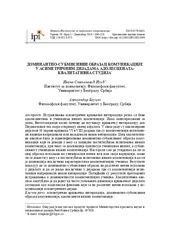| dc.creator | Stepanović Ilić, Ivana | |
| dc.creator | Baucal, Aleksandar | |
| dc.date.accessioned | 2021-10-12T12:47:33Z | |
| dc.date.available | 2021-10-12T12:47:33Z | |
| dc.date.issued | 2018 | |
| dc.identifier.issn | 0579-6431 | |
| dc.identifier.uri | http://reff.f.bg.ac.rs/handle/123456789/2614 | |
| dc.description.abstract | The paper explores asymmetrical peer interaction and focuses on adolescents with higher competences, which is fairly rare in this field. Although interested in language, the Vygotskians dominantly studied adult-child interaction, while the Piagetian research, despite the orientation towards peer interaction, has started to investigate their dialogue only recently. In the current paper, we traced the domination-submissiveness communication pattern in 10 dyad conversations of primary school students (the 6th and 8th grade), in which more competent students progressed or regressed most after an interaction with a less competent peer. This pattern is usually related to a lower achievement of less competent students who were found to be submissive, while domination was a feature of their more competent peers. The aim was to explore whether this pattern had variations and how it was related to the achievement and behaviour of more competent students. The results indicate that there are various forms of the investigated communication pattern and that it is associated with the more competent students' progression. The previous findings regarding the dominant behaviour of more competent students have been confirmed. Qualitative analysis enabled us to see the domination-submissiveness communication pattern as a complex form of interaction which appears in various forms in the dialogues of asymmetric dyads. | en |
| dc.publisher | Institut za pedagoška istraživanja, Beograd | |
| dc.relation | Projekat Ministarstva prosvete, nauke i tehnološkog razvioja br. 197018 | |
| dc.rights | openAccess | |
| dc.rights.uri | https://creativecommons.org/licenses/by-nc-nd/4.0/ | |
| dc.source | Zbornik Instituta za pedagoška istraživanja | |
| dc.subject | more competent adolescents | en |
| dc.subject | domination-submissiveness communication pattern | en |
| dc.subject | asymmetric peer interaction | en |
| dc.title | Domination-submissiveness as a communication pattern in adolescents' dialogue: a qualitative study | en |
| dc.type | article | |
| dc.rights.license | BY-NC-ND | |
| dc.citation.epage | 228 | |
| dc.citation.issue | 2 | |
| dc.citation.other | 50(2): 209-228 | |
| dc.citation.rank | M24 | |
| dc.citation.spage | 209 | |
| dc.citation.volume | 50 | |
| dc.identifier.doi | 10.2298/ZIPI1802209S | |
| dc.identifier.fulltext | http://reff.f.bg.ac.rs/bitstream/id/1316/2611.pdf | |
| dc.identifier.scopus | 2-s2.0-85065773439 | |
| dc.identifier.wos | 000457201200002 | |
| dc.type.version | publishedVersion | |

